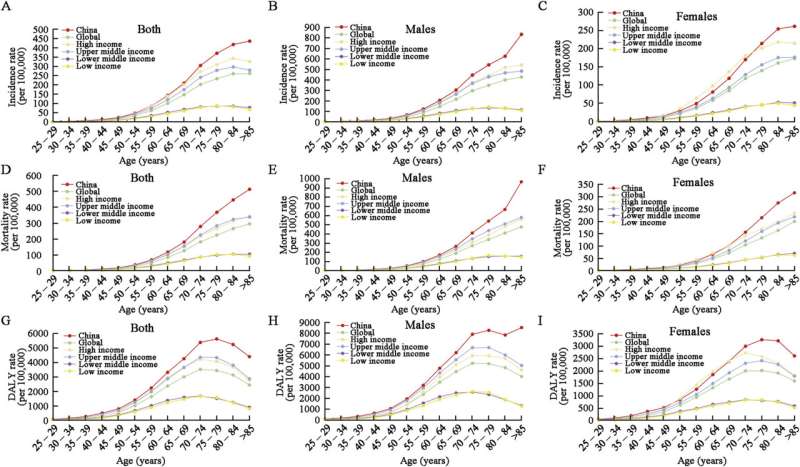This article has been reviewed according to Science X's editorial process and policies. Editors have highlighted the following attributes while ensuring the content's credibility:
fact-checked
proofread
Study uncovers trends in the global burden of tracheal, bronchus, and lung cancer

Tracheal, bronchus, and lung (TBL) cancer contributes significantly to the disease burden globally, increasing expenditure on health and impacting the quality of life. According to estimates, TBL cancer resulted in over two million deaths in 2019 alone.
The incidence, mortality, and disability-adjusted life years (DALYs), defined as the number of healthy years lost due to disease, vary widely across regions and time, contributing to geographical disparities in TBL patterns globally. These geographical and temporal variations in TBL cancer burden patterns may be attributed to variations in exposure to risk factors like smoking, genetic predisposition, or health coverage.
While countries have made concerted efforts to reduce TBL burden, the severity of demographic challenges and exposure to multiple risk factors continues to remain a concern. In a study recently published in the Chinese Medical Journal Pulmonary and Critical Care Medicine, researchers from China have now uncovered geographical and temporal patterns in TBL burden for the period between 1990–2019.
The study, led by Professor Ni Li from the Chinese Academy of Medical Sciences and Peking Union Medical College in China, used data from the Global Burden of Disease (GBD) study, which covers disease trends across 204 countries and territories.
For examining the geographical trends in TBL burden, the team investigated the variations in TBL cancer burden across four income regions defined by the World Bank—high-income countries (HICs), upper-middle-income countries (UMCs), lower-middle-income countries (LMCs), and low-income countries (LICs). Additionally, for examining the temporal trends, they looked at annual percentage changes to the age-standardized incidence rate (ASIR), the age-standardized mortality rate (ASMR), and the age-standardized DALY rate (ASDR).
The study revealed that while TBL cancer burden decreased from 1990 to 2019 globally, there were notable variations across regions and countries. Explaining these findings further, Prof. Li says, "Globally, approximately 2,260,000 new TBL cancer cases, 2,042,600 deaths, and 45,858,000 DALYs were reported in 2019. We observed a decreasing trend in the TBL cancer burden in most of the 21 GBD regions and 204 countries from 1990 to 2019."
The downward trend of the TBL burden was also reflected in its constituent measures—ASIR, ASMR, and ASDR—all of which decreased between 1990–2019 globally.
Moreover, the decline in ASIR, ASMR, and ASDR of TBL cancers was most prominent in HICs. In contrast, UMCs experienced the greatest increases in ASIR and ASMR and reported the highest TBL cancer burden in 2019.
"Eastern Europe experienced the largest mean decrease per year in ASIR, ASMR, and ASDR of TBL cancer over the study period, while Central Europe had the greatest behavioral risk-attributable DALY," says Prof. Li. Of the 204 countries included in the study, the ASIR, ASMR, and ASDR of TBL cancer reflected decreasing trends in 85, 91, and 104 countries, respectively, with the largest decrease recorded in Bahrain.
Furthermore, the researchers also looked at the association between universal health coverage and the TBL cancer burden at the national level. They found geographic disparities in access to health care, pointing to the need for future interventions for early prevention and control of TBL cancer. Notably, there were contrasting trends in ASIR and ASMR of TBL cancer among UMCs compared with that of HICs and LMCs. This was attributed to discrepancies in epidemiological and demographic transitions.
Overall, these results uncover the differences in temporal trends and spatial distribution of TBL cancer burden over two decades and across the world, and underscore the need for improved screening and diagnostic techniques as well as availability of health resources among different income-classified regions.
Moving forward, these findings could provide a valuable roadmap for understanding the trends in TBL cancer burden across regions to help deliver tailored interventions for mitigating them.
More information: Chenran Wang et al, Disparities in the global burden of tracheal, bronchus, and lung cancer from 1990 to 2019, Chinese Medical Journal Pulmonary and Critical Care Medicine (2023). DOI: 10.1016/j.pccm.2023.02.001




















